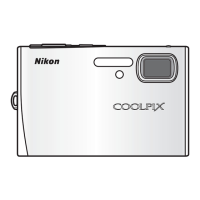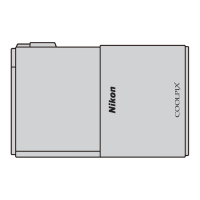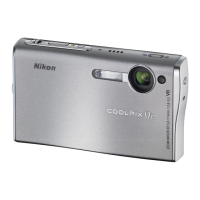
Do you have a question about the Nikon COOLPIX S1200pj and is the answer not in the manual?
| Brand | Nikon |
|---|---|
| Model | COOLPIX S1200pj |
| Category | Digital Camera |
| Language | English |
Essential information to read before operating the camera.
List of items included in the camera package for verification.
Overview of the manual's content and structure.
Explains the symbols and conventions used throughout the manual.
Emphasizes using genuine Nikon accessories to prevent damage.
Recommends taking a test shot before important photo opportunities.
Overarching safety guidelines to prevent damage and injury.
Specific critical warnings regarding potential hazards and misuse.
Specific instructions and warnings for users in the United States.
FCC statement regarding radio frequency interference compliance.
Identifies and describes the physical components of the camera.
Explains fundamental camera navigation and mode switching.
Detailed diagram and list of the camera body's external parts.
Details the function and use of the optional remote control.
Explains the purpose and function of controls used during photography.
Describes controls used for viewing images and movies.
Details controls related to the projector function.
Explains the indicators and information shown on the monitor during shooting.
How to switch between shooting and playback modes on the camera.
Explains how to use the multi selector for navigation and selection.
Guide on how to access and navigate the camera's menu system.
Steps required before shooting, including battery and memory card.
Step-by-step instructions for properly inserting the rechargeable battery.
Detailed steps for charging the camera's battery using the AC adapter.
Instructions for inserting and formatting memory cards for use.
How to power on the camera and check basic indicators.
Procedures for powering the camera on and off.
Explanation of the auto-off and standby mode features.
Guide to setting language, time zone, date, and time upon first use.
Overview of the different shooting modes available on the camera.
Guidance on how to hold the camera and frame the subject.
Explains how to use the zoom control for framing and digital zoom.
Step-by-step process for focusing and releasing the shutter.
How to access and view stored images on the camera.
Options for changing how pictures are displayed, like zoom and thumbnails.
Instructions on how to delete unwanted still images from the camera.
Method for selecting and deleting multiple specific images.
Guide on how to take pictures using the optional remote control.
Details on using the automatic scene selection mode for simple shooting.
Explanation of various scene modes for optimizing settings.
Specific features and usage for Portrait and Landscape scene modes.
How to select image size and quality for saving pictures.
Lists shooting settings that cannot be enabled simultaneously.
How the camera detects and focuses on human faces for better shots.
Using the skin softening function to improve portrait skin tones.
Method for locking focus on off-center subjects.
How to choose specific types of pictures for viewing.
Overview of the different modes for viewing pictures.
Procedure to switch between different picture playback modes.
Details the functions accessible through the playback menu.
Instructions for viewing images on a television.
Steps for transferring images to a computer.
Guide for printing images directly from the camera.
Guide to installing the ViewNX 2 software package.
Detailed steps for transferring images to a computer using USB.
How to view images after they have been transferred.
Using ViewNX 2 tools to edit and retouch photographs.
Using ViewNX 2 Movie Editor for basic movie adjustments.
Printing images using ViewNX 2 and a connected printer.
Introduction to the camera's built-in projector feature.
Step-by-step guide to projecting still images using the camera.
Important notes on using the projector, cover, and stand.
Details on using software to project computer display via USB.
Explains controls used for operating the projector with the camera or remote.
How to control movie playback while projecting.
Steps to set up and play back automated slide shows.
Settings for playback menu and setup menu affecting projector use.
Instructions on how to start and stop movie recording.
Tips for achieving proper focus during movie recording.
Details movie recording formats and maximum duration.
How to configure movie options like resolution and autofocus.
How to play back movies and use playback controls.
Steps to delete movie files from the camera.
Introduction to adjusting various camera settings.
Details available settings in the camera's setup menu.
Settings for playback menu and setup menu affecting projector use.
Detailed guides for advanced shooting techniques.
Detailed guides for image playback and management.
Information on projecting images from external sources.
Detailed guides for movie recording and playback.
Comprehensive guide to camera menu options.
Steps for capturing panoramic photos using the camera's assist feature.
How to organize and play back favorite pictures in albums.
Managing pictures within albums, including viewing and removal.
How the camera automatically sorts pictures into categories.
Viewing pictures based on the date they were captured.
Lists and describes the in-camera editing tools for still pictures.
Guide to using quick retouch for contrast and saturation enhancement.
Using D-Lighting to improve brightness and contrast in dark areas.
Softens skin and enhances facial features for portraits.
Describes various digital filter effects that can be applied to pictures.
Creating smaller copies of pictures for web or email.
How to crop images to recompose or select specific areas.
Steps to connect the camera to a television for playback.
Instructions for printing pictures directly to a PictBridge printer.
Step-by-step guide to printing individual pictures.
Instructions for printing several pictures at once.
Steps to install the PC-PJ Transfer software for computer projection.
Minimum system requirements for installing the projection software.
Detailed instructions for installing the PC-PJ Transfer CD.
Steps to connect the camera to a computer for display projection.
How to start, pause, resume, and exit the projection software.
Guide to saving PowerPoint as JPEG and projecting them.
How to trim and save desired portions of recorded movies.
Adjusting skin softening effect for portraits in smart portrait mode.
Using the smile timer for automatic shutter release in smart portrait mode.
How blink proof helps capture shots with open eyes.
How to adjust white balance for accurate color representation.
Explains single, continuous, BSS, and multi-shot modes.
How to adjust ISO sensitivity for low-light conditions and noise reduction.
How to select the focus area for autofocus.
Selecting between single and continuous autofocus for movies.
How to create a digital print order for compatible printers.
Configuring and running automatic slide shows of pictures.
How to protect selected pictures from accidental deletion.
How to select pictures for various operations like print order or rotation.
How to rotate images to adjust their orientation for display.
Capturing and listening to voice memos attached to pictures.
Transferring pictures between internal memory and memory card.
Selecting movie recording formats and resolution.
Choosing autofocus methods for movie recording.
Using movie light and wind noise reduction features.
Adjusting resolution enhancement for movie recording.
Customizing the camera's startup welcome screen.
Configuring the camera's clock and time zone settings.
Customizing what information is shown on the camera's monitor.
Enabling power saving mode for the projector.
Setting whether to imprint shooting date and time on pictures.
Using vibration reduction to minimize blur from camera shake.
How motion detection helps reduce blur from subject movement.
Using AF-assist light for focusing in low light.
Enabling or disabling the digital zoom feature.
Customizing button and shutter sounds.
Configuring the auto-off timer for power saving.
Steps for formatting internal memory and memory cards.
Selecting the display language for menus and messages.
Configuring USB and video output modes for device connection.
How to charge the camera battery using a computer connection.
Enabling blink detection to alert users about blinking subjects.
How to reset all camera settings to their factory defaults.
Default settings for movie recording options.
Default settings for various camera setup options.
Covers paper size, slide show, and background music settings.
How to view the current camera firmware version.
Explains how files and folders are named on the camera.
Lists common optional accessories available for the camera.
Solutions for issues related to charging, power, and connections.
Troubleshooting for blank or unreadable monitor displays.
Resolving issues with incorrect dates, times, or reset settings.
Solutions when the shutter button or menus don't work.
Addressing issues with camera focus and blurred pictures.
Troubleshooting for digital zoom and image mode availability.
Resolving problems with camera sounds and AF-assist illumination.
Solutions for underexposed, overexposed, and red-eye reduction problems.
Troubleshooting for issues with playing back files and using editing functions.
Resolving problems with auto sort display and Nikon Transfer 2.
Troubleshooting PictBridge startup and printing display issues.
Solutions for paper size selection and unsharp projected images.
Detailed technical specifications of the Nikon COOLPIX S1200pj camera.
Details on exposure metering, control, shutter speed, and aperture.
Specifications for built-in flash, interface, and I/O terminals.
Technical details of the camera's built-in projector.
Details on battery type, charging time, and battery life.
Dimensions, weight, and operating environment for the camera.
Explains symbols and abbreviations used in the manual's index.
Alphabetical listing of terms and their corresponding page numbers.











